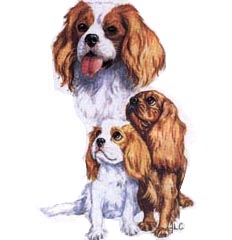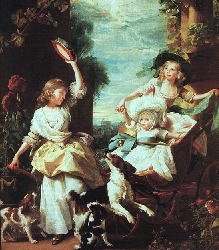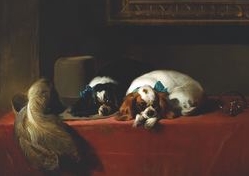
History
If the eyes are the window to the soul, the Cavalier King Charles Spaniel has the kindest soul in the doggy kingdom. Once you peer into the eyes of your Cavalier you will enjoy a vision of complete devotion and will fall completely under their spell.
Kings may have ruled countries but Cavaliers ruled kings. Now they are taking over families around the world!
The first recorded royal person who had a beloved Cavalier spaniel was Mary Queen of Scots. She was beheaded in 1587 and it was reported that a little spaniel walked close under her skirts to the scaffold. The dog would not leave her body until someone picked him up and took him away. Charles I also was beheaded and it was also reported that his black and white Cavalier spaniel named Rogue was at his side. It was under Charles II's rule that the breed became famous. They followed him wherever he went and had the run of the castle. It has been reported that the Queen and her court used the Cavaliers to lay on their hands for warmth when they were riding in their carriages on cool evenings. Hence the nickname "lap dogs". (they really do love to lay in your lap)
The long nosed toy spaniel went out of fashion during the reign of King William when they brought the pug (their favorite breed) from Holland. There may have been some interbreeding between the Pug and the Spaniel and the result was a toy spaniel with a domed head and flat muzzle. The dog was called the King Charles Spaniel or "Toy Spaniel".
In the Victorian era, toy spanels came into the public eye because of the Queen's beloved tri-colored pet named Dash. He was not one of the more popular short nosed spaniels, but is recognized in potraits painted of him as being very much like the modern Cavaliers.
The reappearance of the orginal type of toy spaniel, the Cavalier, is credited to Mr. Roswell Eldridge, an American who went to England to find the beloved dog. He could not find them, so he offered a cash prize for "Blenheim Spaniels" of the old type as shown in the pictures of Charles II's time. This sparked renewed interest by a small goup of dedicated English breeders, led by Mrs. Amice Pitt. The dog that was to be most influential in re-establishing this ancient breed was Ann's Son.
In 1945, once there were a number of the long-faced types in the championship ring, their breeders applied to register them separately.
Cavaliers are still very popular in England with royals, the aristocracy and those high in the government. Princess Margaret, sister of the Queen, treasured one named Rowley who was her companion for many years.
To this breed it doesn't matter if you are a King or commoner, rich or poor, all that matters is that they have someone to love and to be loved by in return.
Legends, Myths, & Facts
More Information:
Country of Origin: England
AKC Group: Toy
Function: Companionship
Life Span: Nine to Eleven Years
Color: Blenheim, Tricolor, Ruby, Black and Tan
Coat: Silky soft, moderate Length, feathering on ears, chest, legs, and tail
Grooming: Brush 2-3 times weekly at the minimum
Height: 12-13 inches at the withers
Weight: proportionate to the height 13-18 lbs
Activity Level: Moderate
Intelligence: High
Trainability: Eager to please but sensitive, responds best to praise
Watchdog Abilities: Poor guard dog
Character: Affectionate, loving, and gentle
Home Environment: Indoor Dogs does best with fenced yard
Good with Kids: Yes
Good with other Pets: Yes
Attitude towards Strangers: Friendly

Why Buy A Cavalier?
Wonderful Personality
Eager to Please
Loves Unconditionally
Easy to Groom
(silky soft tangle free hair)
Non-Aggressive
Great with other animals
Great with kids
Super house pets
Smart
Calm
(nicknamed "lap dogs")
Not excessive barkers
Live to please you
Easy to housetrain


Famous Owners Of Cavaliers
King Charles I
Mary Queen of Scots
Diane Sawyer
Ric Flair
(Owns several Kingston Cavaliers)
Sylvester Stallone
Frank Sinatra
Nancy Reagan
Princess Margaret
Jennifer Love-Hewitt
Willie Aames
Tracey Ullman
Michael J. Fox
Kirk Douglas
Courtney Cox
The Osbourne Family